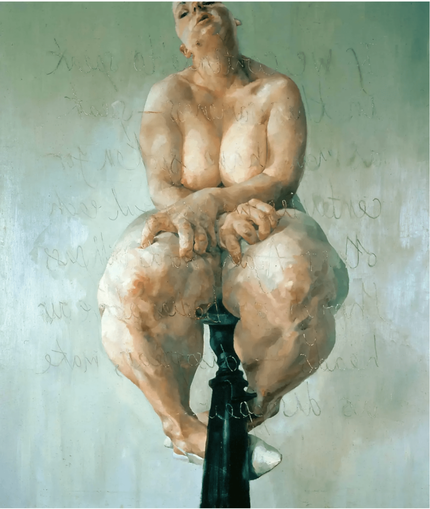On Monday 14th March, LEAF hosted the book launch of the Portuguese book Somos F*das, which records the stories of 16 different women, from Brazil, Portugal and Spain. The event was both powerful and emotional, with many of the women tearing up when relaying their stories. Such an event, falling just after International Women’s Day on the 8th March, seemed apt for the current world environment, reflecting the struggles that many women still face across the world. The team here at LEAF is a firm advocate for equality, and in support of this mission, sponsors two scholarships every year for womxn to undertake Level 3 Diploma studies at the Arts and Business College of London. Alongside this, LEAF endeavours to always bring to light and champion female artists and their work, helping female artists gain fame and repute.
With that being said, today we shall have a look at the works of a British female artist: Jenny Saville.
Jenny Saville, born in Cambridge in 1970, began her art education at the Glasgow School of Art, and during this degree, also spent a term studying at the University of Cincinnati. Upon her graduation, it was the purchase of several of her large-scale works by businessman and art collector Charles Saatchi that catapulted Saville onto the international art scene, and boosted her career as an artist. Since then, Saville has had her work exhibited worldwide, including at the 50th Venice Biennale in 2003, at the Gagosian Gallery New York in 2003, at the Museo d’Arte Contemporaenea in Rome 2005 and at the Modern Art Oxford in 2012. She is also a member of the Young British Artists (YBAs), a group of young creators who forged a name for themselves throughout the 1980s and 90s. She continues to probe and question conceptions of the human body, and especially the female nude, and will certainly be remembered as an iconic artist emblematic of contemporary times. She currently lives and works between London and Palermo, Italy.
Saville is perhaps best known for her large-scale oil paintings of the female body. Her fascination with flesh is manifest in her manipulation of layers of oil paint to bring depth and realism to her depictions of the female body. Indeed, some of her best work is certainly that of fleshy and obese female figures, and the Gagosian Gallery comments that ‘in her depictions of the human form, Jenny Saville transcends the boundaries of both classical figuration and modern abstraction’ (https://gagosian.com/artists/jenny-saville/). This quotation seemingly rings true, as when looking at Saville’s work, such as her 1992 work Propped, her blurring of the line between classical figuration, which strived for aesthetic perfection, and the modern tendency for the stylized is apparent. The rendering of the thighs, hands, and breasts demonstrates Saville’s skill at working in depicting human flesh, while simultaneously raising questions about the role of the viewer and the perception of the female body in the 21st century. The positioning of the body is both closed and open at the same time, with the crossed wrists and ankles contrasting to the extended neck and exposed breasts. The painting questions notions of beauty and forces the viewer to analyse whether such a piece is, should be or should not be, sexualised. In a world where fat-shaming is an all too real fact, such a piece analyses the viewer’s conception of beauty and corpulence in a very modern way. The painting presents an image of female empowerment, but also subtly hints, with her hands clawing at her thighs, at notions of shame; a concept many women around the world feel regularly about their appearance. Such a piece clearly resonates with the viewer, and was chosen by Charles Saatchi to be included in the 1997 exhibition, Sensation: Young British Artists from the Saatchi Collection at the Royal Academy of Arts.
Saville herself has stated her works and style has been greatly influenced by many of the art elite. From Rubens to Rembrandt, to Willem de Kooning and Lucian Freud, Saville has drawn her influence from a plethora of sources. She has also importantly thrown her hat in the ring for the depiction of the female nude. Yet the obvious difference between Saville and many of the other artists known for the female nude is her femininity and womanhood. This offers a different, and much needed, perspective, challenging the male gaze in a tradition that has its roots in male-dominated 4th Century Athens and the Aphrodite of Knidos by Praxiteles. She engages in this old tradition, injects her own touch and reflects on contemporary society. Her voluminous works refuse to be silent, and she is truly an artist of the moment.
The LEAF team hopes that through such introductions to female, British artists, we can help our readers uncover new favourite artists, pieces and movements, while spreading the word about the brilliance of female creators. Saville’s works challenge the status quo, and that is what we at LEAF want to do too. By dispersing more educational content and offering scholarships to those who need it the most, we hope to reduce educational inequality and help the country ‘level up’. Our mission is simple: champion the arts and promote equality, be that in educational circumstances or between the genders.
Sophie Rogers
Jenny Saville, Propped, 1992. Oil on canvas. 84 x 72 inches / 213.4 x 182.9cm © Jenny Saville. Courtesy the artist and Gagosian.

 London Education & Art Foundation
London Education & Art Foundation